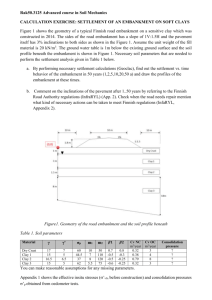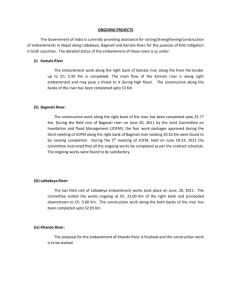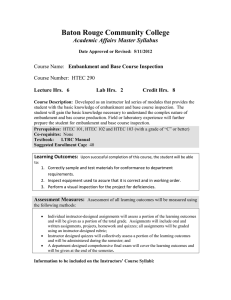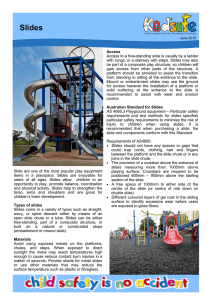IMPACT OF HYDROLOGICAL AND SEISMIC FACTORS ON THE STABILITY OF A HIGH-LEVEL EMBANKMENT BASED ON MARL SOIL CLASS A3 IN THE SOUTH CORRIDOR RIFAIN - HIGHWAY SECTION OF FEZ-TAZA (MOROCCO)
advertisement
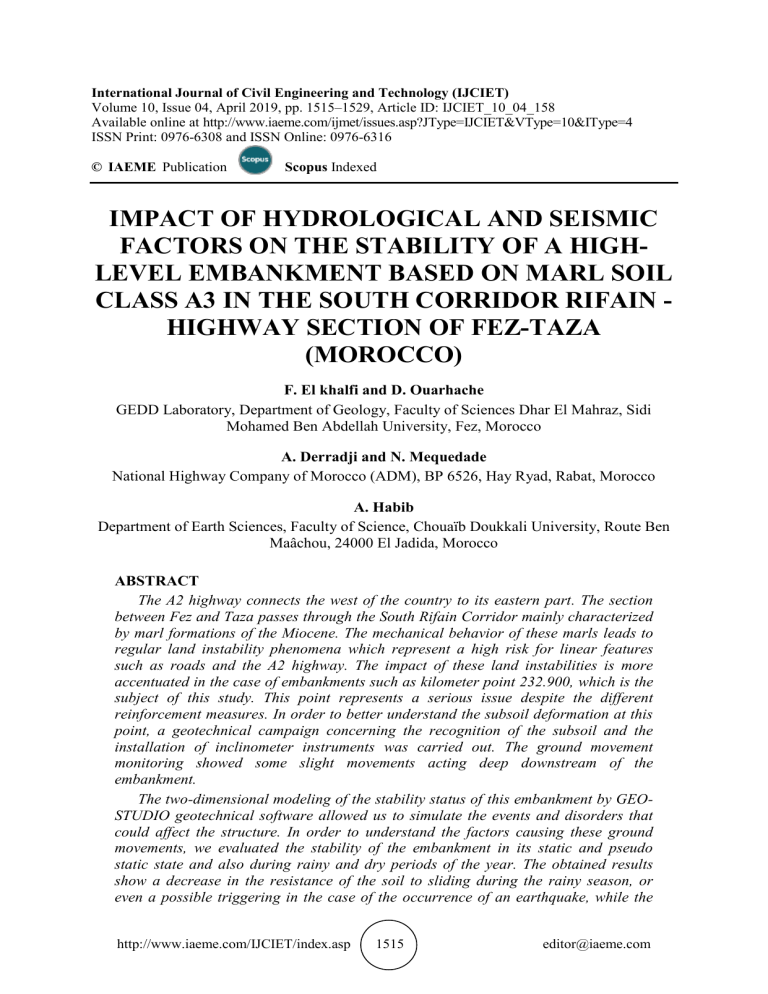
International Journal of Civil Engineering and Technology (IJCIET) Volume 10, Issue 04, April 2019, pp. 1515–1529, Article ID: IJCIET_10_04_158 Available online at http://www.iaeme.com/ijmet/issues.asp?JType=IJCIET&VType=10&IType=4 ISSN Print: 0976-6308 and ISSN Online: 0976-6316 © IAEME Publication Scopus Indexed IMPACT OF HYDROLOGICAL AND SEISMIC FACTORS ON THE STABILITY OF A HIGHLEVEL EMBANKMENT BASED ON MARL SOIL CLASS A3 IN THE SOUTH CORRIDOR RIFAIN HIGHWAY SECTION OF FEZ-TAZA (MOROCCO) F. El khalfi and D. Ouarhache GEDD Laboratory, Department of Geology, Faculty of Sciences Dhar El Mahraz, Sidi Mohamed Ben Abdellah University, Fez, Morocco A. Derradji and N. Mequedade National Highway Company of Morocco (ADM), BP 6526, Hay Ryad, Rabat, Morocco A. Habib Department of Earth Sciences, Faculty of Science, Chouaïb Doukkali University, Route Ben Maâchou, 24000 El Jadida, Morocco ABSTRACT The A2 highway connects the west of the country to its eastern part. The section between Fez and Taza passes through the South Rifain Corridor mainly characterized by marl formations of the Miocene. The mechanical behavior of these marls leads to regular land instability phenomena which represent a high risk for linear features such as roads and the A2 highway. The impact of these land instabilities is more accentuated in the case of embankments such as kilometer point 232.900, which is the subject of this study. This point represents a serious issue despite the different reinforcement measures. In order to better understand the subsoil deformation at this point, a geotechnical campaign concerning the recognition of the subsoil and the installation of inclinometer instruments was carried out. The ground movement monitoring showed some slight movements acting deep downstream of the embankment. The two-dimensional modeling of the stability status of this embankment by GEOSTUDIO geotechnical software allowed us to simulate the events and disorders that could affect the structure. In order to understand the factors causing these ground movements, we evaluated the stability of the embankment in its static and pseudo static state and also during rainy and dry periods of the year. The obtained results show a decrease in the resistance of the soil to sliding during the rainy season, or even a possible triggering in the case of the occurrence of an earthquake, while the http://www.iaeme.com/IJCIET/index.asp 1515 editor@iaeme.com F. El khalfi, D. Ouarhache, A. Derradji, N. Mequedade, A. Habib adoption of the recommended reinforcement structures has shown a good maintenance of the structure in this kilometer point even in the worse conditions. These structures have been adopted as comfort solutions by the highway manager. Key words: Embankment, ground movement, highway, reinforcement, modeling, Morocco. Cite this Article: F. El khalfi, D. Ouarhache, A. Derradji, N. Mequedade, A. Habib, Impact of Hydrological and Seismic Factors on the Stability of a High-Level Embankment Based on Marl Soil Class A3 in the South Corridor Rifain - Highway Section of Fez-Taza (Morocco), International Journal of Civil Engineering and Technology 10(4), 2019, pp. 1515–1529. http://www.iaeme.com/IJCIET/issues.asp?JType=IJCIET&VType=10&IType=4 1. INTRODUCTION The development of linear structures in steep slope terrain with the presence of marly soil exposes them to a high chance risk of instability causing major disorders in the pavement structures with the possibility of disruption of traffic and putting the safety of users at stake. The South Rifain Corridor, sheltering the highway section of Fez-Taza, is widely known by the phenomena of land movements caused mainly by the rugged morphology and the lithological nature of the subsoil. Usually, those movements are due to natural and anthropogenic conditions [1]–[4]. Despite significant progress and advances in this field, the exact determination of each generating factor and their reactivations remain very limited [5], [6]. In the South Rifain Corridor and the Rif in general, the majority of road infrastructures experience major disturbances in the stability of the terrain. The main damages observed are subsidence, differential settlements and landslides. The predominance of soft formations such as marl is an important factor conditioning a disorderly evolution of the slopes [7]. During the implementation phase of the studied highway axis, three project type variants were proposed and all of them pass through the marl formations, which made the possibility of bypassing the corridor very difficult. The embankment realized at kilometer point (PK) 232,900 on the A2 highway has a length of about 300 linear meters with a maximum height of 16m. The first signs of land movement affecting embankment slope were manifested by cracks in the roadway and by small scratches at its northern side. A geotechnical campaign consisting of core drilling of a depth varying from 20m to 35m was carried out in order to perform mechanical reconnaissance tests of the subsoil in addition to the installation of inclinometers to monitor the movements of the ground. In an interval of forty days, the inclinometers recorded displacements of the order of 23mm at the upper twenty meters in the downstream part of the embankment. The present work will attempt to evaluate the main factors causing the instability of this embankment at its upstream and downstream parts. Moreover, the extent of this instability will be estimated through the record of inclinometers. For this purpose, a 2D modeling of the stability of the embankment was performed through GEO-STUDIO software by incorporating several parameters such as the characteristics of the soil (lithology, slope ...), the water factor (precipitation, rise of the water table, clogging of the drainage devices) and the seismic factor. 2. STUDY AREA AND PROBLEMATIC 2.1. Topographic, Geological and Climatic Settings The study area, which is located between Ras Tabouda and Tahla, is characterized by a sinuous and relatively rugged topography with a dominance of marly hills shaped by erosion (Fig.1). The route of the A2 highway, with a SW-NE direction, passes through the South http://www.iaeme.com/IJCIET/index.asp 1516 editor@iaeme.com Impact of Hydrological and Seismic Factors on the Stability of a High-Level Embankment Based on Marl Soil Class A3 in the South Corridor Rifain - Highway Section of Fez-Taza (Morocco) Rifain Corridor, which is in the form of an elongated narrow depression following an eastwest direction with Plio-Quaternary deposits and blue marls, sometimes very sandy with benches of detrital limestone and coarse sandstone (Fig.2). It is characterized by its location between two different domains which are the Rif and the Middle Atlas. The Rif, which is located in the north of the study area, is an alpine chain whose history extends from the Triassic to the Miocene, which is characterized by thrust sheet, back-thrust structures and alpine metamorphism. In the south, the area is limited by the tabular Middle Atlas with an essential carbonate material of Jurassic age [8]–[11]. In climatic terms, the study area is subject to northern Mediterranean influences and those of the Northwest Atlantic with a cold and fresh winter experiencing localized downpours up to 257 mm/month (February 2010) and a hot and dry summer. The average annual rainfall in the area varies from 450 to 600 mm/year [12], placing the region on the edge of area 2, which is known by heavy rainfall between 600 and 800 mm/year, and zone 3 with annual rainfall of 400 to 600 mm/year [13]. Figure 1 (a) Region Fez-Taza. (b ) study area (Credits: Google Maps). (c) limit of the digitized geological map (Fig.2) http://www.iaeme.com/IJCIET/index.asp 1517 editor@iaeme.com F. El khalfi, D. Ouarhache, A. Derradji, N. Mequedade, A. Habib Figure 2 Geological map of the study area showing the major geological units exposed along the A2 highway (Extracted from the geological map of Gharb and Western Prerif). 2.2. Problematic At PK 232,900 on the A2 highway, the embankment was built in a geologically complex context. The investigations conducted have identified the major factors that influence the stability of this structure such as the lithology of the subsoil, the rugged morphology (steep slopes) (Fig.3), the water conditions and the seismic effect of the region. The alternation of dry and wet periods contributes to the accentuation of the instability of the embankment. The rainy period, which is known to have significant rainfall, leads to the saturation of the superficial layers, which can be justified by the appearance of water sources and a liquefiable place in this period. These conditions cause disorders and influence the stability of the structure. Figure 3 Terrain profile following section AB (fig.1.b) and embankment representation The major factors that may be the cause of the internal and external instability of the embankment are: The properties of the soil, slope, slope height, weather influences, the position of the water table, and the static and dynamique overloading [14]. These factors http://www.iaeme.com/IJCIET/index.asp 1518 editor@iaeme.com Impact of Hydrological and Seismic Factors on the Stability of a High-Level Embankment Based on Marl Soil Class A3 in the South Corridor Rifain - Highway Section of Fez-Taza (Morocco) influence the safety factors (SF) of the landslide which are defined by [15] as the ratio of the moment of the efforts that can be mobilized at the moment of the applied forces (driving moment) (Fig. 4). Figure 4 Schematic of an embankment with stability calculation parameters [15] 3. METHODOLOGY AND MATERIALS The methodology adopted in this study is based on the following points: Choice of implementation of field surveys; Installation and monitoring of inclinometers; Soil sampling and laboratory tests; Soil classification analyzes; Representation of the 2D perspective of the embankment condition. 3.1. Choice of implementation of field surveys In order to choose the optimal location for the core drill holes, several criteria were retained such as the adjacent places of the hydraulic structure, the section of maximum height and the zones which present indices of ground movements. These core drillings made it possible to perform underground reconnaissance and install instruments to control the stability of the embankment (fig.5). Figure 5 Map of the studied embankment and boreholes positioning http://www.iaeme.com/IJCIET/index.asp 1519 editor@iaeme.com F. El khalfi, D. Ouarhache, A. Derradji, N. Mequedade, A. Habib 3.2. Installation and monitoring of inclinometers The inclinometers installed on the slope in accordance with standard NF P 94-156 (inclinometer measurements) are intended to control the displacement of the soil of the different strata traversed by the cored holes and to follow the evolution of ground movements as well as to serve as an alarm. In order to monitor the ground displacements of the embankment, we have used only two boreholes which can be considered more significant according to their locations as well as the recording of major displacements: (i) borehole no. SPC-1 (Figs.5 & 6), with 28 m of depth and a recorded displacement of about 20 mm in a monitoring interval of 202 days; (ii) borehole no. SPC-2 (Figs.5 & 7), with 30.5 m of depth and a recorded displacement of about 23 mm for 40 days’ interval. Figure 6 Measure of cumulation of soil displacement by the inclinometer in the SPC-1 borehole for a period of 202 days [16] Figure 7 Measure of cumulation of soil displacement by the inclinometer in the SPC-2 borehole for a period of 40 days [16] http://www.iaeme.com/IJCIET/index.asp 1520 editor@iaeme.com Impact of Hydrological and Seismic Factors on the Stability of a High-Level Embankment Based on Marl Soil Class A3 in the South Corridor Rifain - Highway Section of Fez-Taza (Morocco) 3.3. Soil sampling and laboratory tests Soil identification tests The core holes (Fig. 5) were designed to characterize the subsoil at depths between 20 and 35m, which allowed us the processing of samples taken at depths 14m; 21.5m and 22m to perform recognition tests (gradation test, cone liquidity limit and roll plasticity limit) according to NM13.1.008, P94-052-1 and P94-051 standards, respectively. The obtained results show that all the soils analyzed have plasticity indices greater than 25 and fine elements (<80 μm) greater than 93% (Table 1). Based on these tests and following the [17] classification, the studied soil can be considered as clay soil with high plasticity and water sensitivity. Table 1 Soil identification carried out by [16] Sample reference & Depth (m) SCP 2-R15 (14,20m14,50m) SCP 8-R15 (21,00m21,50m) SCP 9-R15 (21,50m22,00m) Sampling method & retention Liquidity limit the cone NF P94-052-1 Roll Plasticity Limit NF P94-051 Limit of Liquidity Index of plasticit limit WL plasticity y WP (%) IP (%) (%) Particle size analysis by dry sieving after washing - NM 13.1.008 Dmax mm > 50 mm >2 m m 2mm to 80μm <80 μm Poll & Carrot 50 21 29 1.25 0 0 0 100 Poll & Carrot 44 18 26 2.50 0 0 7 93 Poll & Carrot 51 23 28 0.80 0 0 0 100 With: WL: Liquidity limit WP: Limit of plasticity NF: French standard NM: Moroccan standard IP: plasticity index Dmax: the Maximum dimension of the coarsest element Mechanical tests of soil The intrinsic characteristics cohesion and angle of friction (C, Φ') of Coulomb are obtained by the triaxial test according to the standard NF P94-074. In order to be able to extract relatively reliable mechanical parameters at ground breaking, strict monitoring of the sampling and storage methods has been ensured. These tests were performed on so-called intact samples as recommended by [18]. The fracture’s characteristics (internal friction angle and cohesion) obtained in the laboratory characterize the soil as a cohesive material (Table 2). Table 2 Mechanical characteristics of soil [16] Triaxial test: Produced according to NF P94-074 CU + U Sample Reference SCP2 (14.20m-14.50m) SCP9 (21.50m-22.00m) Effective constraint C '( Kpa ) Φ ' (°) 26 18 ° 24 18 ° Total constraint Ccu ( Kpa ) Φ cu (°) 38 17 ° 34 17 ° With: NF: French standard C': drained cohesion http://www.iaeme.com/IJCIET/index.asp 1521 CCU : total undrained editor@iaeme.com F. El khalfi, D. Ouarhache, A. Derradji, N. Mequedade, A. Habib cohesion CU + U: Undrained consolidated test Φ': effective angle of with measurement of interstitial friction, expressed in pressure degrees Φ cu : total friction angle, expressed in degrees Soil classification analyzes The main parameters used for soil classification are those of nature, mechanical behavior, and condition, according to the booklet 2 from [17]. Samples taken at varying depths are consisting mainly of marls with sieves at 80μm greater than 90%. The parameters are considered sufficient to identify and classify soils. Table 1 summarizes the results of the nature parameters obtained in the laboratory. According to the GTR classification, the three samples are classified in the soil class A3, which is characterized by a high cohesion with average water content and sticky or slippery in the wet state [17]. These characteristics are identical to those obtained by [19] , in Oued Amlil - Taza Corridor. The three marly processed samples collected at depths of 14m and 21m are mostly very plastic to plastic clay materials according to the classification map of Casagrande [18]. 3.4. Representation of the 2D perspective of the embankment condition Geometric characteristics of the embankment Projection of high-speed roads requires respect of geometric safety parameters. The geometrical characteristics of the backfill are: The total length of embankment: 300 m linear meters, Maximum height: 16 m, Upper width: 25m (2x7m pavement, 2x2.5m stop band, and central solid ground), Lower width: 80m base of the embankment. Geotechnical Cross-Section The synthesis of the nine cored pressuremeter test enabled the creation of a 3D block diagram for the three profiles at the following kilometric points: PK: 232.820; PK: 232,860 and PK: 232,900 (Fig. 8). Figure 8 a 3D block diagram of the studied embankment http://www.iaeme.com/IJCIET/index.asp 1522 editor@iaeme.com Impact of Hydrological and Seismic Factors on the Stability of a High-Level Embankment Based on Marl Soil Class A3 in the South Corridor Rifain - Highway Section of Fez-Taza (Morocco) 4. RESULTS OF ANALYZES AND MODELING The field reconnaissance surveys have shown that the backfill is generally composed of a series of marl strata of A3 class according to the GTR classification [17]. The topographic conditions show that the embankment fills a concave area which retains the tributaries of the surrounding hills. The surface water collected by wastewater facilities and those of tributaries are normally discharged through a two-opening scupper-type wastewater structure under the embankment. When there is a malfunction of wastewater facilities (clogging), the entire structure is exposed to the risk of instability. Using the GEO-STUDIO modeling software and processing of landslides, we have modeled the stability status of the embankment by three methods of computation, viz. [20]– [22], to know and compare the safety factor (SF) limits to generate the landslide and see the scenarios that can occur with the introduction of the parameters that influence the release of ground movements. 4.1. Presentation of the GEO-STUDIO modeling software The GEO-STUDIO is a software of computation, analysis and geotechnical modeling which gathers several programs. One of which is GEO-SLOPE/W, which has been used to model the embankment structure of the present work. GEO-SLOPE/W uses the limit equilibrium theory to calculate the slope safety factor for rock and soil; it can analyze simple and complex stability problems using a different methods of calculating safety factor. It has the ability to model heterogeneous soil types, complex lithology and various geometries with varying conditions of pore water pressure using a wide variety of soil models. The analyzes can be performed with deterministic or probabilistic input parameters. In addition, the calculated voltages for finite element stress analysis can be used in limit equilibrium calculations for slope stability analysis [23]. 4.2. Modeling of embankment behavior Static stability method during the dry period This season is characterized by a relative lack of rainfall and, consequently, a significant drawdown of the water table is expected. During the core drilling during the months of April and May, the piezometric level was encountered between four and six meters or even nine in some surveys. To model the structure in the SLOPE/W software, we have introduced the parameters that characterize the terrain as the geometry and the properties of the different strata of the subsoil (density γ, values of the effective stresses C 'and Φ' and the piezometric level). The strata that make up the embankment and the base are mainly marl. The base soil is formed from top to bottom by a layer of thin marly clay followed by yellow to green marl with a consistency of about 10 meters, and at the base, there are grey indurated and compact marls. Generally speaking, marl has good mechanical properties in the dry state, while, in the wet state, its behavior changes towards a degradation of its resistance [24]. The 2D modeling of the terrain profile under the conditions mentioned above has shown that there is a total stability of the fill-sitting during the dry period (Fig. 9). http://www.iaeme.com/IJCIET/index.asp 1523 editor@iaeme.com F. El khalfi, D. Ouarhache, A. Derradji, N. Mequedade, A. Habib Figure 9 The embankment behavior during the dry period Static and pseudo-static stability method during the rainy season The study area experiences regular rainfall during the wet period of the year which starts from November to April and is sometimes accompanied by violent downpours. The Zrarda village weather station, located 17 km southeast of the zone, collected an average of 257 mm of precipitation during the month of February 2010 as a peak between 1998 and 2015. This amount of significant precipitation, spread over one month, deeply feeds the superficial formations that consist mainly of altered marly soils with drying slots of the order of a few centimeters shaped following the alternation of wet-dry seasons. When the marly formations are saturated, they suffer from the swelling and shrinkage phenomena. For this purpose, the marls of the embankment and the subsoil become more compressible after the alternation of these swelling and shrinkage phenomena in comparison with the original compressibility [25]. In addition, the marly soil during the rainy season experiences very remarkable changes in the parameters of nature (water content, density) and intrinsic mechanical characteristics (cohesion and internal friction). It has a considerable sensitivity to the action of air and water, causing its deterioration in case of lack of superficial coating [24]. Some boreholes realized in the bed of the tributaries have shown that there is a layer of brown clay of thickness ranging from 1m to 3.5m which is probably formed by the accumulation of upstream eroded sediments. The presence of a layer of marly clay confined between the ground and the embankment in the wet state makes the soil very compressible and develops weak resistance [26]. This increases when the clay strata shows a greater thickness. To evaluate the influence of the water factor on the stability of the backfill and its foundation, we integrated the effects of rising water levels, overloads applied by heavy vehicles in addition to horizontal and vertical seismic constraints. The seismic constraints, according to the Moroccan Parasismic Regulation RPS2000 (version 2011), were calculated according to Eurocode 8 part 5 [27] by the formulas: In the horizontal direction In the vertical direction F H = 0.5 α W F V = 0.5 F H (1) (2) With: F : the design value of the horizontal seismic inertia force F : Calculation value of the vertical seismic force of inertia W: the weight of the moving mass α: design value of the seismic coefficient of the soil H V http://www.iaeme.com/IJCIET/index.asp 1524 editor@iaeme.com Impact of Hydrological and Seismic Factors on the Stability of a High-Level Embankment Based on Marl Soil Class A3 in the South Corridor Rifain - Highway Section of Fez-Taza (Morocco) By applying these formulas, the horizontal and vertical seismic forces obtained are 0.14 and 0.07 respectively, according to regional seismic data. Figures 10 and 11 illustrate the embankment modeling under the influence of the increase of piezometric level by using static and pseudo-static stability methods. Figure 10 Embankment behavior in the rainy period by static stability method Figure 11 Embankment behavior in the rainy season by pseudo-static stability 4.3. Embankment condition modeling with stability devices To ensure the stability of the embankment, we proposed some stability structures to protect it from risks of instability, even in pseudo-static situations. To validate these stability features, we examined the behavior of the embankment with the geotechnical modeling program GEOSLOPE, where we introduced a deep drainage mechanism upstream of the embankment and reinforced concrete piles downstream to retain the stop forces applied by masses that can be slid. After the adoption of the embankment protection techniques, it appears that there is a significant stability justified by the safety factors obtained during the modeling by the three calculation methods. Even with non-convenient water and seismic conditions, the SF is greater than 1.5, as shown in Figures 12 and 13. http://www.iaeme.com/IJCIET/index.asp 1525 editor@iaeme.com F. El khalfi, D. Ouarhache, A. Derradji, N. Mequedade, A. Habib Figure 12 Embankment behavior with the stabilization structures by static stability method Figure 13 Embankment behavior with the stabilization structures by pseudo-static stability method Table 3 summarizes safety factors of the landslide during dry and wet periods, in static and pseudo-static states, with and without comfort devices. Table 3 Summary of the slip safety actors obtained Calculation Dry period method at SS Janbu Bishop Ordinary 1.58 1.68 1.63 The wet period in SS 1.06 1.20 1.11 Wet period at SPS 0.97 1.08 1.02 Wet period with CS to SS 1.79 1.87 1.83 Wet period with CS to SPS 1.53 1.66 1.57 With : SS : Static state CS : comfort structure http://www.iaeme.com/IJCIET/index.asp 1526 SPS : State pseudo-static editor@iaeme.com Impact of Hydrological and Seismic Factors on the Stability of a High-Level Embankment Based on Marl Soil Class A3 in the South Corridor Rifain - Highway Section of Fez-Taza (Morocco) 5. DISCUSSION AND RECOMMENDATIONS 5.1. The reaction of embankment under the influence of destabilizing factors The obtained results by modeling the embankment during the rainy season allowed us to observe an increase in the driving moments, and consequently a decrease of the shear resistance. In general, streams that are often punctual have a strong impact on the hydraulic loads below the slid mass [28], which is manifested by a decrease in safety factors (SF) as shown in Table 3. The SFs obtained by the static calculation method varies between 1.06 and 1.20. These values fall into the interval [1-1,2] considered by [29] as a threshold below which landslides can appear. By keeping the same conditions analyzed by the static method and using the seismic constraints, the SFs are less than 1, which informs us that the driving forces are greater than the resistant ones and the release of the masses is certain. For this reason, the adoption of comfort and protection structures is necessary. In both cases during the rainy season, there is saturation or near saturation of marl soils with Class A3, serving as a base for the high bank, which leads to a significant reduction of the safety factor caused by the change in soil behavior. 5.2. The reaction of the embankment with stability structures As first stability structures, we adopted a draining trench upstream of the embankment which aims to collect and to drain all the runoff water and those infiltrated through the cracks created by small tearing at the superficial level of the marly formations. This drainage system aims to ensure the proper evacuation of water likely to be stagnated near the embankment in case of dysfunction of wastewater facilities (water descent, concrete ditches, etc.) and to transport it to the outflow by avoiding any source of infiltration inside the strata. A second structure was adopted downstream of the so-called rigid embankment represented by a fence of reinforced concrete piles with a spacing of 2.5m anchored in the compact gray marl formation at a depth ≥ 24m to retain and confine the forces generated by the start of masses that can be slid (Fig. 13) and transmit them in depth to the resistant layer. These two adopted stability structures have played directly on the safety factors when the embankment slips from critical SF of less than 1 (Fig. 10) to SF greater than 1.5 (Fig. 11 and 12), which is considered largely safe to any possibility of movement even under the effect of the earthquake. Embankment modeling using the GEO-SLOPE software allowed us to visualize the slope manifestations after the integration of the seismic parameters, the rise of the piezometric level and the overloads applied by heavy vehicle traffic. Figures 11 and 12 show that the embankment is stable with an SF greater than 1.5 in both static and pseudo-static conditions. 6. CONCLUSIONS The instability of the embankment often occurs because of the diversity of the driving factors that generate the ground movements (marly nature of the subsoil and embankment, water conditions, topography, seismic effect ...). The results obtained from the identification and mechanical soil tests characterize the soil as a fine clay material sensitive to climatic variation and have a cohesive aspect with high plasticity “Class A3”. During the evaluation of the results obtained by modeling, we noticed that during the rainy season, the water conditions and the seismic effect of the region represent the main causes of the landslide. With the variation of the hydric regime, the marl coming from the embankment or the subsoil undergoes a shrinkage-swelling phenomenon causing, therefore, the decrease of the safety factors and consequently exposes the structure to a high risk of instability. Another factor that can be at the origin of several disorders consists in the existence of clays on the surface of the http://www.iaeme.com/IJCIET/index.asp 1527 editor@iaeme.com F. El khalfi, D. Ouarhache, A. Derradji, N. Mequedade, A. Habib underlying soil foundations, with thickness ranging between 1m to 3.5m which, when saturated, can play the role of soap strata favorable to sliding. Thus, considering the risks to which users may be exposed, and the high cost of site maintenance work, we recommend two comfort devices to mitigate the impact of these phenomena. The first consists of the realization of a highly effective drainage mechanism on the upside of the embankment, with draining trench type, to prevent the infiltration of any source of water inside. The second comprises a contiguous jointed piles barrier anchored in the compact gray marl layer as stopping force. The integration of these two structures into the modeling program has allowed us to obtain safety factors higher than 1.5, a value recognized as a safety threshold for structures. These structures have been adopted as comfort solutions by the highway manager. REFERENCES [1] R. Dikau, D. Brunsden, L. Schrott, et M. L. Ibsen, Landslide Recognition, Identification, Movement and Causes , Pure Appl. Geophys., vol. 151, no 1, p. 188–188, 1996. [2] A. Lang, J. Moya, J. Corominas, L. Schrott, et R. Dikau, « Classic and new dating methods for assessing the temporal occurrence of mass movements », Geomorphology, vol. 30, no 1‑2, p. 33–52, 1999. [3] F. C. Dai, C. F. Lee, et Y. Y. Ngai, « Landslide risk assessment and management: an overview », Eng. Geol., vol. 64, no 1, p. 65–87, 2002. [4] M. J. Crozier et T. Glade, « The nature of landslide hazard impact », Landslide Hazard Risk Wiley Lond., p. 43–74, 2005. [5] F. Guzzetti, A. Carrara, M. Cardinali, et P. Reichenbach, « Landslide hazard evaluation: a review of current techniques and their application in a multi-scale study, Central Italy », Geomorphology, vol. 31, no 1, p. 181–216, 1999. [6] T. W. Van Asch, J.-P. Malet, L. P. Van Beek, et D. Amitrano, « Techniques, issues and advances in numerical modelling of landslide hazard », Bull. Société Géologique Fr., vol. 178, no 2, p. 65–88, 2007. [7] A. Tribak, « Quelques exemples de mouvements de terrain dans le Prérif oriental (Maroc) », Méditerranée, vol. 86, no 1, p. 61‑66, 1997. [8] H. Feinberg, « Les séries tertiaires du Prérif et des dépendances post-tectoniques du Rif », PhD Thesis, Thèse d’Etat. Sc. Nat, Univ Toulouse, 1978. [9] [9] P. Cirac, « Le Bassin sud-rifain occidental au néogène supérieur: évolution de la dynamique sédimentaire et de la paléogeographie au cours d’une phase de comblement », PhD Thesis, 1985. [10] M. Kili, « Les ostracodes néogènes du sillon sud-rifain (bassin du Rharb, de Saïs et de Taounate): paléontologie, paléoenvironnements et paléogéographie », PhD Thesis, Thèse de DES, université de Rabat, Maroc, 1993. [11] N. Barhoun et N. B. Taoufiq, « Événements biostratigraphiques et environnementaux enregistrés dans le corridor sud rifain (Maroc septentrional) au Miocène supérieur avant la crise de salinité messinienne », Geodiversitas, vol. 30, no 1, p. 21–40, 2008. [12] ABHS, Agence du Bassin Hydraulique du Sebou: Débat national sur l’eau. 2006. [13] S. Riad, « Typologie et analyse hydrologique des eaux superficielles à partir de quelques bassins versants représentatifs du Maroc », PhD Thesis, Atelier de reproduction des thèses, 2003. http://www.iaeme.com/IJCIET/index.asp 1528 editor@iaeme.com Impact of Hydrological and Seismic Factors on the Stability of a High-Level Embankment Based on Marl Soil Class A3 in the South Corridor Rifain - Highway Section of Fez-Taza (Morocco) [14] I. Gueye, « Résistance au cisaillement des sols non saturés et stabilité des pentes », Thèse, Ecole Polytechnique Fédérale de Lausanne, 1994. [15] J. Costet et G. Sanglerat, Cours pratique de mécanique des sols 2. Calcul des ouvrages. Dunod, 1983. [16] LPEE-CES, « Etude de reconnaissance géotechnique par sondages carotés », Maroc, Technique, 2013. [17] SETRA et LCPC, « Guide technique, Réalisation des remblais et des couches de forme. Fascicule II. Annexe technique », Guid. LCPC, p. 102, juill. 2000. [18] P. Martin, Géotechnique appliquée au BTP, Editions Eyrolles. Paris, 2008. [19] M. Mouhssine, A. Touzani, S. Zinoune, et A. Mahtal, « Terrassements sur terrains marneux sensibles aux glissements: cas des terrains et remblais autoroutiers entre Oued Amlil et Taza (Rif, Maroc) », Physio-Géo Géographie Phys. Environ., no Volume 9, p. 61–80, 2015. [20] W. Fellenius, « Calculation of the stability of earth dams. Proc., 2nd Congress on Large Dams, International Commission on Large Dams, Washington, DC », p. 445‑462, 1936. [21] N. Janbu, « Application of composite slip surfaces for stability analysis. Proceedings, Europiean Conferenc on Stability of Earth Slopes,Sweden,3 pp.43-49. », 1954. [22] A. W. Bishop, « The use of slip circle in the stability analysis of slopes. Géotechnique », vol. 5, no 1, p. 7‑17, 1955. [23] [23] GEO-SLOPE International Ltd, « Tutorial Manuals, Alberta, 5th edn, Canada ». 2004. [24] B. Gaudin, « Pressions de terrain sur une galerie creusée dans des marnes du stampien », Bull. Liais. Lab. Ponts Chauss., no 59, mai 1972. [25] J.-F. Serratrice, « Retrait-gonflement des sols argileux et des marnes », Rev. Fr. Géotechnique, no 120‑121, p. 107‑120, 2007. [26] O. Boudlal, « Etude expérimentale du comportement mécanique des fines dans la stabilité des talus et des fondations », PhD Thesis, Université Mouloud Mammeri, 2013. [27] P. EuroCode 8, « Conception et dimensionnement des structures pour leur résistance aux séismes et Document d’Application Nationale Partie 5 : Fondations, ouvrages de soutènement et aspects géotechniques ». 2000. [28] A. Parriaux, C. Bonnard, et L. Tacher, « Glissements de terrain: hydrogéologie et techniques d’assainissement par drainage. Guide pratique. », Office Fédéral de l" environnement OFEV, 2010. [29] O. Lateltin, « Prise en compte des dangers dus aux mouvements de terrain dans le cadre des activités de l’aménagement du territoire », Recomm. OFEFP, vol. 42, 1997. http://www.iaeme.com/IJCIET/index.asp 1529 editor@iaeme.com
